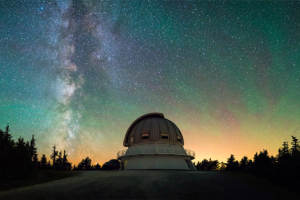Our History

The Mont-Mégantic Observatory (OMM), nestled near Sherbrooke, Québec, has a storied history dating back to its inauguration in 1978. Born from a vision to advance astronomy education in Quebec and bolster cutting-edge research, this institution has left an indelible mark on Canadian astronomy.
At its core, the observatory boasts a formidable 1.6-metre telescope with a colossal one-tonne mirror, a testament to its commitment to scientific excellence. This telescope, the largest in eastern North America and fourth-largest in Canada, sets itself apart through its state-of-the-art instruments, rendering it the most potent astronomical tool in the country.
The genesis of this ambitious project can be traced back to 1971 when Professors Gilles Beaudet and George Michaud of the Université de Montréal conceived the idea. In 1974, the Université Laval in Quebec City joined forces with them, culminating in a partnership agreement in 1975. Government approvals in 1976 paved the way for construction, with the service building completed in 1977 and the Observatory itself inaugurated in 1978.
The Université de Montréal’s Prof. René Racine, who joined the project in 1973, served as its Director for much of its early history, steering its course until his retirement in 1997. Throughout its existence, the Observatory has been involved in significant research, including studies on galaxy dynamics, stellar interactions with interstellar matter, and polarimetry of young stellar objects.
Innovation has thrived at the Mont-Mégantic, with dynamic instrument development propelling its research agenda. Notably, in 1982, a new Fabry-Perot interferometer was designed for the Observatory, followed by the introduction of an infrared camera, MONICA, in 1991, marking a Canadian first.
The OMM’s commitment to public engagement materialised with the opening of the Mont-Mégantic ASTROLab in 1996. It offers interactive displays, a high-definition movie, multimedia presentations, and access to the Observatoire populaire du Mont-Mégantic (OPMM) and smaller telescopes during astronomy evenings.
Substantial renovations commenced in 1999, including the repair and ventilation of the 1.6-metre telescope’s dome. Fiber optics connectivity to universities in 2000, full computerisation of telescope controls in 2001, and the installation of a new bonnet further modernised the facility. A slew of cutting-edge instruments followed suit thanks to the OMM’s Experimental Astrophysics Laboratory (LAE). These include instruments currently in operation at the OMM, as well as others that have been sent to international observatories on the ground and in space. Among others, the OMM’s LAE participated in the development of the Canadian FGS/NIRISS instrument aboard the James Webb Space Telescope.
In 2008, the OMM contributed to a groundbreaking discovery, participating in the direct imaging of an exoplanetary system orbiting a distant star, HR 8799, for the first time. This achievement was made possible through the development and testing of the angular differential imaging technique at Mont-Mégantic.
In 2015, the Université de Montréal and McGill University collaborated to establish the Trottier Institute for Research on Exoplanets (iREx), further solidifying the Observatory’s role as a nexus for exoplanetary research.
Asteroid 4843 was aptly named in honor of the OMM, a testament to its enduring legacy in advancing astronomical science and education. After celebrating its 45th anniversary in 2023, the OMM and its team continue to look ahead, developing new astronomical instruments, training the next generation of astronomers, and delighting the public with inspiring discoveries.
